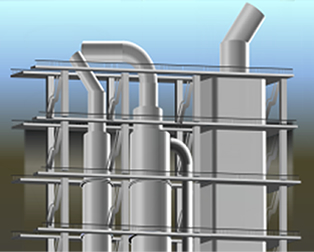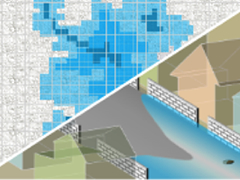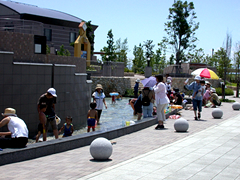
Since its founding, Showa Sekkei has been engaged in architectural design and urban development while also serving as a water and sewage service consultant. Life and water are inseparable. Our lifestyles exist because of the deep interrelation between urban development and the establishment of water environments. As an urban development consultant, Showa Sekkei is engaged in the creation of water environments and considers their ideal correlation to cities.
Up until now, gases and sludge generated in sewage treatment processes have been disposed. However, due to recent technological developments, there has been a focus on using such materials as effective renewable energy sources and they have begun to be utilized accordingly. In addition, the upper spaces of sewage treatment plants which require large areas are expected to be effectively used as surplus space for cities.
In order to meet clients’ requirements, Showa Sekkei engages in the development of facilities that create energy, always keeping in mind the best mix of the latest technologies and effective use of space.


- Impurities contained in biogas are removed by way of contact with water through pressurization. Because of purification technologies biogas has a quality equivalent to natural gas and is used for natural gas vehicles, city gas and fuel for power.

- Urban gasification is a technique of adjusting gas purified by biogas purification equipment to the quality of urban gas through processes such as O2 removal and LPG and odorant addition. Such gas is already being supplied to households in some areas.

- By reducing construction costs and shortening construction periods, steel plate nitrification tanks reduce the environmental load during construction when compared to concrete nitrification tanks.
Installment of sensors and viewing windows are relatively easy, contributing to stable operations. 
- With the multiple installments of highly effective and downsized digestion gas generators, it is possible to flexibly address the changes in the production of digestion gas and also to ensure a certain amount of generated power, even during power failure.

- Since solar power generation enables effective use of upper spaces of treatment facilities, it is considered to be a source of renewable energy suitable for treatment stations. It is environmentally friendly with no emissions accompanying power generation.

- As with solar power generation, wind generation is an environmental friendly facility with no emissions accompanying power generation. With the characteristic of being able to generate power during the night as well depending on wind conditions, it is utilized at several treatment stations.

- These are technologies that generate power with impellers and water wheels using the freefall of water at gutters, and an amount of power corresponding to the amount of water flow is generated in contrast to generation that uses natural phenomena such as solar power generation.

- These technologies manufacture carbonized fuel by heating dried sewage sludge in anoxic conditions while leaving as much combustible content as possible. The fuel is used for thermal power generation and such.
A computer simulation called runoff analysis, which provides a model for sewer networks and ground surfaces, is used to predict which areas will flood and to what extent when unusually heavy rains happening about once every ten years occur. Using runoff analysis, we strive to create more effective and rational anti-flooding plans and engage in the creation of safe living environments regarding water.

Water that has been treated at treatment stations is often used to supply fountains, small waterfalls and ponds seen indoors, outdoors and integrated at such stations. This water is treated to have an even higher quality than usual so that there will be no hygienic problems. We are engaged not only in returning treated water to rivers and the ocean but also in the development of facilities that will be enjoyed by many people, as well as water environments that provide relief and comfort.











